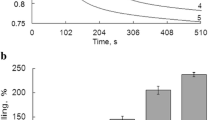Abstract
Rat liver mitochondria, in different steps of the maturation process, were resolved by differential centrifugation at 1000g (M1), 3000g (M3), and 10,000g (M10), and their characteristics determining susceptibility to stress conditions were investigated. Some parameters did not show gradual changes in the transition from M10 to M1 fraction because of the contamination of the M10 fraction by microsomes and damaged mitochondria with relatively high lipid content. The highest and lowest rates of O2 consumption and H2O2 production were exhibited by M1 and M10 fractions, respectively. Vitamin E and coenzyme Q levels were significantly higher in M10 than in M1 fraction, whereas whole antioxidant capacity was not significantly different. The degree of oxidative damage to lipids and proteins was higher in M1 and not significantly different in M3 and M10 fractions. The order of susceptibility to both oxidative challenge and Ca2+-induced swelling was M1 > M3 > M10. It seems that the Ca2+-induced swelling is due to permeabilization of oxidatively altered inner membrane and leads to discard mitochondria with high ROS production. If, as previous reports suggest, mitochondrial damage is initiating stimulus to mitochondrial biogenesis, the susceptibility of the M1 mitochondria to stressful conditions could be important to regulate cellular ROS production. In fact, it should favor the substitution of the oldest ROS-overproducing mitochondria with neoformed mitochondria endowed with a smaller capacity to produce free radicals.
Similar content being viewed by others
REFERENCES
Åkerman, K. E. O., and Wikström, K. F. (1976). FEBS Lett. 68, 191–197.
Barja, G. (1999). J. Bioenerg. Biomembr. 31, 347–366.
Bernardi, P. (1992). J. Biol. Chem. 267, 8834–8839.
Burton, G. W., Joyce, A., and Ingold, K. U. (1983). Arch. Biochem. Biophys. 221, 281–290.
Chance, B., Sies, H., and Boveris, A. (1979). Physiol. Rev. 59, 527–605.
Chen, H., Pellet, L. J., Anderson, H. J., and Tappel, A. L. (1993). Free Radic. Biol. Med. 14, 473–482.
Davies, K. J. A., Quintanhilla, A.T., Brooks, G. A., and Packer, L. (1982). Biochem. Biophys. Res. Commun. 107, 1198–1205.
Di Meo, S., de Martino Rosaroll, P., and De Leo, T. (1992). Cell Physiol. Biochem. 2, 283–292.
Di Meo, S., Venditti, P., and De Leo, T. (1996). Experientia 52, 786–794.
Dionisi, O., Galeotti, T., Terranova, T., and Azzi, A. (1975). Biochim. Biophys. Acta 403, 292–300.
Forsmark-Andrée, P., Åberg, F., Norling, B., Nordenbrand, K., Dallner, G., and Ernster, L. (1991). FEBS Lett. 285, 39–43.
Fatterpaker, P., Bhuvaneswaran, C., Patwardhan, M.V., and Sreenivasan, A. (1965). In Proceedings of the ICRO International Conference on Cell Biology, Bombay (University Press, eds.), Bombay, p. 445.
Gear, A. R. L. (1965). Biochem. J. 95, 118–137.
Gornall, A. G., Bardawill, C. J., and David, M. M. (1949). J. Biol. Chem. 177, 751–766.
Gutteridge, J. M. C. (1987). Biochem. J. 243, 709–714.
Hamberger, A., Gregson, N., and Lehninger, A. L. (1969). Biochim. Biophys. Acta 186, 373–383.
Heath, R. L., and Tappel, A. L. (1976). Anal. Biochem. 76, 184–191.
Hyslop, P. A., and Sklar, L. A. (1984). Anal. Biochem. 141, 280–286.
Kuff, E. I., and Schneider, W. C. (1954). J. Biol. Chem. 206, 677–685.
Lang, J. K., Gohil, K., and Packer, L. (1986). Anal. Biochem. 157, 106–116.
Lanni, A., Moreno, M., Lombardi, A., and Goglia, F. (1996). Int. J. Biochem. Cell. Biol. 28, 337–343.
Loschen, G., Azzi, A., Richter, C., and Flohé, L. (1974). FEBS Lett. 42, 68–72.
Loschen, G., Flohé, L., and Chance, B. (1971). FEBS Lett. 18, 261–264.
Nohl, H., and Stolze, K. (1992). Free Radic. Res. Commun. 16, 409–419.
Papa, S., and Skulachev, V. P. (1997). Mol. Cell. Biochem. 174, 305–319.
Reznick, A. Z., and Packer, L. (1994). Methods Enzymol. 233, 357–363.
Satav, J. G., Katyare, S. S., Fatterpaker, P., and Sreenivasan, A. (1976). Biochem. J. 156, 215–223.
Schild, L., Reinheckel, T., Wiswedel, I., and Augustin, W. (1997). Biochem. J. 328, 205–210.
Sies, H. (1986). Angew. Chem. Int. Ed. Engl. 25, 1058–1071.
Skulachev, V. P. (1996). Quart. Rev. Biophys. 29, 169–202.
Stadtman, E. R. (1993). Annu. Rev. Biochem. 62, 797–821.
Turrens, J. F., Alexandre, A., and Lehninger, A. L. (1985). Arch. Biochem. Biophys. 237, 408–414.
Turrens, J. F., and Boveris, A. (1980). Biochem. J. 191, 421–427.
Tzagoloff, A. (1982). Mitochondria, Plenum Press, New York.
Venditti, P., Di Meo, S., and De Leo, T. (1996). Cell Physiol. Biochem. 6, 283–295.
Venditti, P., De Leo, T., and Di Meo, S. (1997). J. Exp. Biol. 200, 909–914.
Venditti, P., De Leo, T., and Di Meo, S. (1999a). Methods Enzymol. 300, 245–252.
Venditti, P., Daniele, M. C., Masullo, P., and Di Meo, S. (1999b). Cell Physiol. Biochem. 9, 38–52.
Venditti, P., Masullo, P., and Di Meo, S. (1999c). Arch. Biochem. Biophys. 368, 112–120.
Venditti, P., Masullo, P., and Di Meo, S. (2001). Int. J. Biochem. Cell. Biol. 33, 293–301.
Vercesi, A. E., Kowaltowski, A. J., Grijalba, M. T., Meinicke, A. R., and Castilho, R. F. (1997). Biosci. Rep. 17, 43–52.
Yang, J., Liu, X., Bhalla, K., Kim, C. N., Ibrado, A. M., Cai, J. Y., Peng, T. I., Jones, P. D., and Wang, X. D. (1997). Science 275, 1129–1132.
Author information
Authors and Affiliations
Corresponding author
Rights and permissions
About this article
Cite this article
Venditti, P., Costagliola, I.R. & Meo, S.D. H2O2 Production and Response to Stress Conditions by Mitochondrial Fractions from Rat Liver. J Bioenerg Biomembr 34, 115–125 (2002). https://doi.org/10.1023/A:1015175925756
Issue Date:
DOI: https://doi.org/10.1023/A:1015175925756




